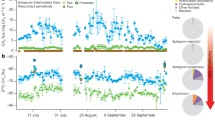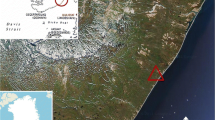Abstract
Permafrost thaw can bring negative consequences in terms of ecosystems, resulting in permafrost collapse, waterlogging, thermokarst lake development, and species composition changes. Little is known about how permafrost thaw influences microbial community shifts and their activities. Here, we show that the dominant archaeal community shifts from Methanomicrobiales to Methanosarcinales in response to the permafrost thaw, and the increase in methane emission is found to be associated with the methanogenic archaea, which rapidly bloom with nearly tenfold increase in total number. The mcrA gene clone libraries analyses indicate that Methanocellales/Rice Cluster I was predominant both in the original permafrost and in the thawed permafrost. However, only species belonging to Methanosarcinales showed higher transcriptional activities in the thawed permafrost, indicating a shift of methanogens from hydrogenotrophic to partly acetoclastic methane-generating metabolic processes. In addition, data also show the soil texture and features change as a result of microbial reproduction and activity induced by this permafrost thaw. Those data indicate that microbial ecology under warming permafrost has potential impacts on ecosystem and methane emissions.






Similar content being viewed by others
References
Allison SD, Treseder KK (2011) Climate changes feedbacks to microbial decomposition in boreal soils. Fungal Ecol 4:362–374
Anisimov OA, Nelson FE (1996) Permafrost distribution in the Northern Hemisphere under scenarios of climatic change. Glob Planet Change 14:59–72
Anthony KMW, Zimov SA, Grosse G, Jones MC, Anthony PM, Chapin FS III, Finlay JC, Mack MC, Davydov S, Frenzel P, Frolking S (2014) A shift of thermokarst lakes from carbon sources to sinks during the Holocene epoch. Nature 511:452–456
Barbier BA, Dziduch I, Liebner S, Ganzert L, Lantuit H, Pollard W, Wagner D (2012) Methane cycling communities in a permafrost-affected soil on Herschel Island, Western Canadian Arctic: active layer profiling of mcrA and pmoA genes. FEMS Microbiol Ecol 82:287–302
Chapin FS III, Sturm M, Serreze MC, McFadden JP, Key JR, Lloyd AH et al (2005) Role of land-surface changes in Arctic summer warming. Science 310:657–660
Christensen TR, Johansson T, Åkerman HJ, Mastepanov M (2004) Thawing sub-arctic permafrost: effects on vegetation and methane emissions. Geophys Res Lett 31:1–4
Conrad R, Erkel C, Liesack W (2006) Rice Cluster I methanogens, an important group of Archaea producing greenhouse gas in soil. Curr Opin Biotech 17:262–267
Coolen MJL, Orsi WD (2015) The transcriptional response of microbial communities in thawing Alaskan permafrost soils. Front Microbiol 6:1–14
Coolen MJL, van de Giessen J, Zhu EY, Wuchter C (2011) Bioavailability of soil organic matter and microbial community dynamics upon permafrost thaw. Environ Microbiol 13:2299–2314
DeLong EF (1992) Archaea in coastal marine environments. PNAS 89:5685–5689
Deng J, Gu Y, Zhang J, Xue K, Qin Y, Yuan M, Yin H, He Z, Wu L, Schuur EAG, Tiedje JM, Zhou J (2015) Shifts of tundra bacterial and archaeal communities along a permafrost thaw gradient in Alaska. Mol Ecol 24:222–234
Ernakovich JG, Wallenstein MD (2015) Permafrost microbial community traits and functional diversity indicate low activity at in situ thaw temperatures. Soil Biol Biochem 87:78–89
Garcia JL, Ollivier B, Whitman WB (2006) The order Methanomicrobiales. Prokaryotes 3:208–230
Good IJ (1953) The population frequencies of species and estimation of population parameters. Biometrika 40:237–264
Graham DE, Wallenstein MD, Vishnivetskaya TA, Waldrop MP, Phelps TJ, Pfiffner SM et al (2012) Microbes in thawing permafrost: the unknown variable in the climate change equation. ISME J 6:709–712
Grosskopf R, Stubner S, Liesack W (1998) Novel euryarchaeotal lineages detected on rice roots and in the anoxic bulk soil of flooded rice microcosms. Appl Environ Microbiol 64:4983–4989
Hales BA, Edwards C, Ritchie DA, Hall G, Pickup RW, Saunders JR (1996) Isolation and identification of methanogen-specific DNA from blanket bog peat by PCR amplification and sequence analysis. Appl Environ Microbiol 62:668–675
Hallam SJ, Girguis PR, Preston CM, Richardson PM, DeLong EF (2003) Indentification of methyl coenzyme M reductase A (mcrA) genes associated with methane-oxidizing archaea. Appl Environ Microbiol 69:5483–5491
Hultman J, Waldrop MP, Mackelprang R, David MM, McFarland J, Blazewicz SJ et al (2015) Multi-omics of permafrost, active layer and thermokarst bog soil microbiomes. Nature 521:208–212
Jansson JK, Tas N (2014) The microbial ecology of permafrost. Nat Rev Microbiol 12:414–425
Jin H, Wu J, Cheng G, Tomoko N, Sun G (1999) Methane emissions from wetlands on the Qinghai–Tibet Plateau. Chin Sci Bull 44:2282–2286
Jin HJ, Li SX, Wang SL, Zhao L (2000) Impact of climatic change on permafrost and cold regions environment in China. Acta Geogr Sin 55:161–173
Kang X (1996) The features of climate change in the Qinghai–Tibetan Plateau region in the past 40 years. J Glaciol Geocryol 18(Suppl. 1):281–288
Kendall MM, Boone AD (2006) The order Methanosarciales. Prokaryotes 3:244–256
Lawrence DM, Slater AG (2005) A projection of severe near-surface permafrost degradation during the 21st century. Geophys Res Lett 32:1–5
Liebner S, Ganzert L, Kiss A, Yang S, Wagner D, Svenning MM (2015) Shifts in methanogenic community composition and methane fluxes along the degradation of discontinuous permafrost. Front Microbiol 6:1–10
Luton PE, Wayne JM, Sharp RJ, Riley PW (2002) The mcrA gene as an alternative to 16S rRNA in the phylogenetic analysis of methanogen population in landfill. Microbiology 148:3521–3530
Mackelprang R, Waldrop MP, DeAngelis KM, David MM, Chavarria KL, Blazewicz SJ, Rubin EM, Jansson JK (2011) Metagenomic analysis of a permafrost microbial community reveals a rapid response to thaw. Nature 2011:368–371
McCalley CK, Woodcroroft BJ, Hodgkins SB, Wehr RA, Kim EH, Mondav R, Crill PM, Chanton JP, Rich VI, Tyson GW, Saleska SR (2014) Methane dynamics regulated by microbial community response to permafrost thaw. Nature 514:478–481
McGuire AD, Anderson LG, Christensen TR, Dallimore S, Guo L, Hayes DL, Heimann M, Lorenson TD, Macdonald RW, Roulet N (2009) Sensitivity of the carbon cycle in the Arctic to climate change. Ecol Monogr 79:523–555
Meng J, Xu J, Qin D, He Y, Xiao X, Wang F (2014) Genetic and functional properties of uncultivated MCG archaea assessed by metagenome and gene expression analysis. ISME J 8:650–659
Metje M, Frenzel P (2005) Effect of temperature on anaerobic ethanol oxidation and methanogenesis in acidic peat from a northern wetland. Appl Environ Microbiol 71:8191–8200
Mondav R, Woodcroft B, Kim EH, McCalley CK, Hodgkins SB, Crill PM et al (2014) Discovery of a novel methanogen prevalent in thawing permafrost. Nat Commun 5:3212
Nunoura T, Oida H, Miyazaki J, Miyashita A, Imachi H, Takai K (2008) Quantification of mcrA by fluorescent PCR in methanogenic and methanotrophic microbial communities. FEMS Microbiol Ecol 64:240–247
Ochsenreiter T, Selezi D, Quaiser A, Bonch-Osmolovskaya L, Schleper C (2003) Diversity and abundance of Crenarchaeota in terrestrial habitats studied by 16S RNA surveys and real time PCR. Environ Microbiol 5:787–797
Osterkamp TE, Viereck L, Shur Y, Jorgensons MT, Racine C, Doyle A, Boone RD (2000) Observations of thermokarst and its impact on boreal forests in Alaska, USA. Arct Antarct Alp Res 32:303–315
Rivkina E, Shcherbakova V, Laurinavichius K, Petrovskaya L, Krivushin K, Kraev G, Pecheritsina S, Gilichinsky D (2007) Biogeochemistry of methane and methanogenic archaea in permafrost. FEMS Microbiol Ecol 61:1–15
Sakai S, Imachi H, Hanada S, Ohashi A, Harada H, Kamagata Y (2008) Methanocella paludicola gen. nov., sp. nov., a methane-producing archaeon, the first isolate of the lineage ‘Rice Cluster I’, and proposal of the new archaeal order Methanocellales ord. nov. Int J Syst Evol Microbiol 58:926–936
Schloss PD, Handelsman J (2005) Introducing DOTUR, a computer program for defining operational taxonomic units and estimating species richness. Appl Environ Microbiol 71:1501–1506
Schloss PD, Westcott SI, Ryabin T, Hall JR, Hartmann M, Hollister EB et al (2009) Introducing mothur: open-source, platform-independent, community-supported software for describing and comparing microbial communities. Appl Environ Microbiol 75:7537–7541
Schuur EAG, Bockheim J, Canadell JG, Euskirchen E, Field CB, Goryachkin SV et al (2008) Vulnerability of permafrost carbon to climate change: implications for the global carbon cycle. Bioscience 58:701–714
Schuur EAG, Vogel JG, Crummer KG, Lee H, Sickman JO, Osterkamp TE (2009) The effect of permafrost thaw on old carbon release and net carbon exchange from tundra. Nature 459:556–559
Smith LC, MacDonald GM, Velichko AA, Beilman WD, Borisova OK, Frey KE, Kremenetski KV, Sheng Y (2004) Siberian peatlands: a net carbon sink and global methane source since the early Holocene. Science 303:353–356
Steven B, Leveille R, Pollard WH, Whyte LG (2006) Microbial ecology and biodiversity in permafrost. Extremophiles 10:259–267
Steven B, Wayne HP, Charles WG, Lyle GW (2008) Microbial diversity and activity through a permafrost/ground ice core profile from the Canadian high Arctic. Environ Microbiol 10:3388–3403
Sturn M, Racine C, Tape K (2001) Climate change: increasing shrub abundance in the Arctic. Nature 411:546–547
Takai K, Horikoshi K (2000) Rapid detection and quantification of members of the archaeal community by quantitative PCR using fluorogenic probes. Appl Environ Microbiol 66:5066–5072
Vitt DH, Halsey LA, Zoltai SC (2000) The changing landscape of Canada’s western boreal forest: the current dynamics of permafrost. Can J For Res 30:283–287
Wagner D (2008) Microbial communities and processes in Arctic permafrost environments. In: Dion P, Nautiyal CS (eds) Microbiology of extreme soils. Springer, Berlin, pp 133–154
Wagner D, Kobabe S, Pfeiffer EM, Hubberten HW (2003) Microbial controls on methane fluxes from a polygonal tundra of the Lena Delta, Siberia. Permafr Periglac 14:173–185
Wang G, Qian J, Cheng G, Lai Y (2002) Soil organic carbon pool of grassland soils on the Qinghai–Tibetan Plateau and its global implication. Sci Total Environ 291:207–217
Wang P, Huang X, Pang S, Zhu Y, Lu Z, Zhuang S, Liu H, Yang K, Li B (2014) Geochemical dynamics of the gas hydrate system in the Qilian Mountain permafrost, Qinghai, Northwest China. Mar Petrol Geol 59:72–90
Wei S, Cui H, He H, Hu F, Su X, Zhu Y (2014) Diversity and distribution of Archaea community along a stratigraphic permafrost profile from Qinghai–Tibetan Plateau, China. Archaea 2014. (Article ID240817)
Woo MK (1992) Impacts of climatic variability and change on Canadian wetlands. Can Water Resour J 17:63–69
Yang M, Nelson FE, Shiklomanov NI, Guo D, Wan G (2010a) Permafrost degradation and its environmental effects on the Tibetan Plateau: a review of recent research. Earth Sci Rev 103:31–44
Yang ZP, Ou YH, Xu XL, Zhao L, Song MH, Zhou CP (2010b) Effects of permafrost degradation on ecosystem. Acta Ecol Sin 30:33–39
Zhang T, Barry RG, Knowles K, Heginbottom JA, Brown J (1999) Statistic and characteristics of permafrost and ground-ice distribution in the Northern Hemisphere. Polar Geogr 23:132–154
Zimov SA, Schuur EAG, Chapin FS (2006) Permafrost and the global carbon budget. Science 312:1612–1613
Acknowledgements
The authors acknowledge James Hurley at the University of Colorado for making a critical reading and revision of this paper. This research was supported by Funds of Oil and Gas Survey, China Geological Survey (GZH201400308 and GZH201400306).
Author information
Authors and Affiliations
Corresponding authors
Additional information
Communicated by A. Oren.
Electronic supplementary material
Below is the link to the electronic supplementary material.
Rights and permissions
About this article
Cite this article
Wei, S., Cui, H., Zhu, Y. et al. Shifts of methanogenic communities in response to permafrost thaw results in rising methane emissions and soil property changes. Extremophiles 22, 447–459 (2018). https://doi.org/10.1007/s00792-018-1007-x
Received:
Accepted:
Published:
Issue Date:
DOI: https://doi.org/10.1007/s00792-018-1007-x




